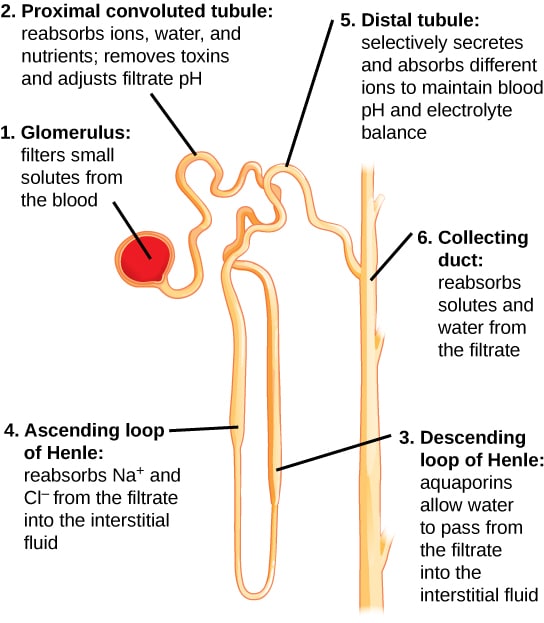Majority of Water Reabsorption in Kidney
99 of the glomerular filtrate volume primary urine 120 mlmin 99 of the filtrated sodium and 99 of the filtered Chloride are reabsorbed in the renal tubules of the nephron. Reabsorption of water and nutrients from the fi ltrate is facilitated.

Water Absorption An Overview Sciencedirect Topics
Match the region of the kidney tubule with its description 1.

. Urine concentration and volume depend on water reabsorption in the. That recovery occurs in the PCT loop of Henle DCT and the collecting ducts and. Distal convoluted tubule and collecting ducts.
Increased ADH secretion and increased water reabsorption. One feature of renal blood circulation that makes it unique is that. Tubular Reabsorption of Sodium Chloride and Fluids.
Most of the fluid that is filtered at the glomerulus is then reabsorbed in the proximal tubule and the descending limb of the loop of Henle. Amino acids are reabsorbed in this. Click to select 4.
Click to see full answer. The predominant extracellular anion is. Dbulk transport by means of endocytosis.
In addition the proximal tubule passively reabsorbs about 23 of water and most other substances. From the ureter to the bladder peristalsis. Loop of Henle - reabsorbs 25 percent of filtered Na.
Which area of the kidney contains the glomeruli and Bowmans capsule. The majority of water reabsorption that occurs in the nephron is facilitated by the AQPs. The diluted filtrate that goes into the descending loop is concentrated as water is also reabsorbed but the absolute amount of water reabsorbed here is less.
Collecting duct - reabsorbs the remaining 2 percent only if the hormone aldosterone is present. Where does majority of reabsorption take place in the kidney. I was taught the proximal convulated tubule is where most of the water absorption occurs.
The majority of water reabsorption from the filtrate occurs in the proximal convoluted tubule PCT. Most of the fluid that is filtered at the glomerulus is then reabsorbed in the proximal tubule and the descending limb of the loop of Henle. Various portions of the nephron differ in their capacity to reabsorb water and specific solutes.
Loop of Henle long U-shaped portion of the tubule that conducts urine within each nephron qv of the kidney of reptiles birds and mammals. The nephrons are the part of the kidneys that are responsible both for the absorption and re-absorption of water within the kidneys. Most of the fluid that is filtered at the glomerulus is then reabsorbed in the proximal tubule and the descending limb of the loop of Henle.
What part of the nephron performs the majority of the reabsorption of materials from the fi ltrate. The diffusion of water from an area of high water potential to an area of low water potential through a partially permeable membrane. The majority of water reabsorptionthat occurs in the nephronis facilitated by the AQPs.
Makes the kidney tubules more permeable to water. During a kidney transplant procedure the renal artery and vein of the donor kidney are connected to the recipients. It is permeable to water which means that H 2 O molecules are freely able to leave it.
Csecondary active transport by means of a sodium-water symporter. The majority of water reabsorption that occurs in the nephron is facilitated by the AQPs. The majority of water reabsorption that occurs in the nephron is facilitated by the AQPs.
The needed energy rises linearly with the NaCl-Reabsorption. Where does a majority of secretion take place. What structure carries urine out of the kidney and where does it go.
Permeability to water and solutes in this region varies based on hormone regulation. Most water reabsorption takes place in the proximal convoluted tubules part of the nephrons in the kidney. How does the loop of Henle work.
The majority of reabsorption occurs in the. The reabsorption is energy consuming process. By the end of the PCT the concentration of water in the filtrate and interstitial space is almost the same.
Water reabsorption occurs in the thin descending limb of the Loop of Henle. The correct answer was given. Site where the majority of reabsorption takes place.
The primary mechanism of water reabsorption in the kidney is aprimary active transport by means of a protein pump. The nephron is the functional unit of the kidney which plays key role in the removal of waste product from the body. The countercurrent multiplier is a system by which the.
Click to select 2. The Bowmans capsule and glomerulus. In which part of the kidney does the majority of water reabsorption occur.
Proximal tubule - reabsorbs 65 percent of filtered Na. Distal tubule - reabsorbs 8 percent of filtered Na. Most of the fluid that is filtered at the glomerulus is then reabsorbedin the proximal tubule and the descending limb of the loop of Henle.
Most of the filtrate reabsorption takes place here too. Contains simple squamous epithelium in the thin segments. Water is reabsorbed by a process called osmosis.
Catalyses the formation of angiotensin I. With up to 180 liters per day passing through the nephrons of the kidney it is quite obvious that most of that fluid and its contents must be reabsorbed. In humans the system accounts for 45 of the kidneys reabsorption of sodium and 5 of the kidneys reabsorption of water.
Reabsorption of sodium at ascending limb and reabsorption of water at ascending limb. Click to select 3. Overall about 67 of the filtered water is reabsorbed in the PCT.
Each nephron has at least two capillary networks.

Tubular Reabsorption Article Article Khan Academy

0 Response to "Majority of Water Reabsorption in Kidney"
Post a Comment